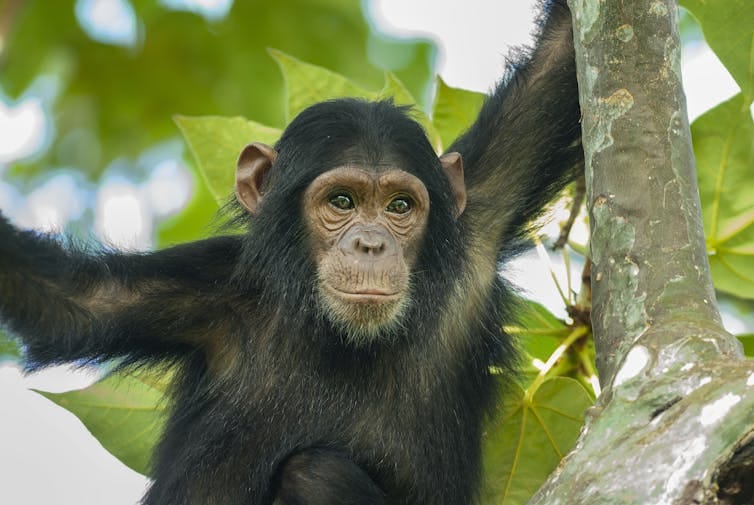Taxonomy explained: Why scientists use Latin and Greek to name species
Some say Latin names are elitist and incomprehensible, but they started out as a way to be inclusive.
A bottlenose dolphin? Or Tursiops truncatus? Why biologists give organisms those strange, unpronounceable names
By Nicholas Green, Kennesaw State University
Most people would call it a “field mouse,” but a scientist would ask, “Was it Peromyscus maniculatus? Or Peromyscus leucopus?”
Scientists use a system of complicated-sounding names to refer to everyday creatures, a practice heavily lampooned in the Warner Bros. cartoons featuring the Road Runner and Wile E. Coyote – or, respectively, Accelleratii incredibus and Carnivorous vulgaris.
As a biologist, I use these seemingly odd names myself and help my students learn them. For most people it’s a huge effort, like learning a second language. That’s because it is.

Humans, skunks and maple trees
The science of naming and classifying organisms is called taxonomy. Scientists do this so they can be as precise as possible when discussing living things.
The first word in an organism’s name is its genus, which is a group of related species, such as Panthera for lions, tigers and leopards.
The second word is the specific name identifying the species, usually defined as a population that can reproduce only with each other, such as Panthera leo for lion.
Every two-word combination must be unique. Called binomial nomenclature, this naming system was popularized by Swedish naturalist Carl Linnaeus in the 1700s. So, humans are Homo sapiens, the red maple Acer rubrum, garlic Allium sativum, and the eastern spotted skunk Spilogale putorius.
Today, biologists maintain huge databases containing the taxonomic names of plants, animals, fungi and other organisms. For instance, one of these databases – the Open Tree of Life project – includes over 2.3 million species.
The scientist who discovers a species usually names it by publishing a formal description in a peer-reviewed journal. From there, the name makes its way into the databases. From then on, scientists always use that name for the organism, even if it turns out to be misleading. For example, many fossils were originally given names containing the Greek root “saur,” which means lizard – even though paleontologists later realized dinosaurs were not lizards.

Snobbery isn’t the issue
To most people, these names sound inscrutable. Particularly nowadays, as science becomes more open and accessible to everyone, such arcane vocabulary can come across as old-fashioned and elitist.
Given the current backlash against “elites” and “experts” in every field, that’s a serious charge. But in a roundabout way, this seemingly exclusive practice is really a story of inclusiveness.
As modern science began taking shape in Europe during the 1600s, scientists had a problem. They wanted to read and be read by others, but language got in the way. French scientists couldn’t read Swedish, Swedes couldn’t read Italian, and Italians couldn’t read German.
Also, writing about plants and animals posed a particular challenge: Many species had common names that could vary from place to place, and some common names might apply to multiple species. Scientists needed a way to be precise and consistent when referring to species, so that everyone could understand each other.
To sidestep the language issue, scientists of the era mostly published their work in classical Latin. Back then, everyone learned it – at least every European man wealthy enough to attend school and become a scientist. Others published in classical Greek, also widely taught. By sticking with these more universally known languages, early scientists made sure that science was accessible to as many of their peers as possible.
By the late 1700s and 1800s, translation services were broadly available, so naturalists such as Georges Cuvier could write in his native French, and Charles Darwin in his native English. Today, English has become the de facto language for science, so most scientists publish in English regardless of their native tongue.
So why continue to use Latin and Greek names today? Taxonomists do it partly out of tradition, but partly because the terminology is still useful. Even without seeing a photo of the animal, a biologist might work out that Geomys bursarius – “earth-mouse with a pouch” – was a pocket gopher. Or that Reithrodontomys fulvescens – “groove-toothed mouse that is yellow” – is a yellow mouse with grooves on its incisors.
What’s in a name?
Although taxonomists still largely adhere to the naming principles of Linnaeus, new scientific names are more and more frequently derived from non-European languages. For example, a chicken-size dinosaur discovered and named in China is called Yi qi, meaning “strange wing” in Mandarin.
Some of the more recent names are touched by whimsy, with a few honoring politicians and celebrities. Etheostoma obama is a spangled darter named after the 44th U.S. president; the Swift twisted-claw millipede – Nannaria swiftae – is named after pop star Taylor Swift.
With so much of Earth’s biodiversity yet to be discovered and named, remember that names are just names. What we call these species often reflects our own values and perspectives.
In the future, another language – or no language at all – might rise to dominance. Artificial intelligence may act as a universal translator. This possibility would let everyone publish and read science in their own language. Predicting how technology will change our relationship with terminology is challenging, but the need for precise scientific language, including the names of species, will never go away.
Nicholas Green, Assistant Professor of Biology, Kennesaw State University
He does not work for, consult, own shares in or receive funding from any company or organization that would benefit from this article, and has disclosed no relevant affiliations beyond their academic appointment.
Thank you for reading today’s Afternoon Story. We hope you found it engaging, informative, and thought-provoking.
If you enjoyed this post, please consider liking or sharing it with others with the heart icon or restack button.




Nice introduction to Taxonomy, and it’s father Linnaeus 👍
Absolutely awesome article entirely, thank you very much, Nicholas and The Conversation US and please, please, please keep 'em comin'!
I recall reading of certain taxonomers' exasperation (was it?) with biologists who mixed Greek and Latin in one name, or named a bacterium after the first host from whom/which they'd isolated it.
This latter delighted me a lot because (i) at the time, a lot of things were delighting me a lot and (ii) at the time, I had thrown myself headlong into trying my best how best to figure out how to try to figure out how badgers might infect cattle with TB in Ireland and Great Britain, and it struck me that, by having named it Mycobacterium bovis rather than, say Mycobacterium (of which AI tells me, 'derived from the New Latin Mycobacterium, which combines the Greek words mykēs (μύκης), meaning "mushroom" or "fungus," and baktērion (βακτήριον), meaning "small rod" or "small staff."!') meles or meles meles after Broc, the badger, instead, the scales had been tipped long, long ago, and our prejudices well established.
(And, just in case it may help anyone else to know, I found that what an academic colleague had told me seemed to prove true in my own case. He told me that a passionate enthusiasm was likely to carry a researcher farther, deeper than any other attributes. Sure enough, once I had fully committed myself to trying to unravel the mystery, door after door after door after door opened in front of me. Not only this, but my "subconscious" seemed to go into complete overdrive analyzing by night for me reams and reams of stats which I had neither the learning, the energy, the wit nor the enthusiasm to attempt to analyze by day, so that I repeatedly surfaced to ask myself "How in Earth could anyone, ever - even the {or this?} most boring person on the planet - possibly, even in his wildest dreams, dream of...statissstics?!"
Years later, I was intrigued to read of Otto Loewi’s nightwork:
‘Loewi is also known for the means by which the idea for his experiment came to him. On Easter Saturday 1921, he dreamed of an experiment that would prove once and for all that transmission of nerve impulses was chemical, not electrical. He woke up, scribbled the experiment onto a scrap of paper on his night-stand, and went back to sleep.
The next morning, he found, to his horror, that he couldn't read his midnight scribbles. That day, he said, was the longest day of his life, as he could not remember his dream. That night, however, he had the same dream. This time, he immediately went to his lab to perform the experiment.[11] From that point on, the consensus was that the Nobel was not a matter of "if" but of "when."’ - from https://en.wikipedia.org/wiki/Otto_Loewi as well as of songs arriving in the dreams of others.
Once Science commits itself to harnessing the power of placebo and of our “subconscious,” any arguments about how to name things may be history?)
Heartfelt thanks, again!
Tom.